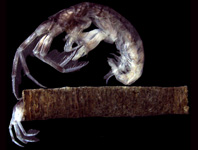Abstract
The genus Leielmis was recently revised by Bilton (2017), who established the identity of the type species Leielmis georyssoides (Grouvelle, 1890), and described two new taxa: Leielmis gibbosus Bilton, 2017, widespread in the Cape Fold Mountains and Leielmis hirsutus Bilton, 2017, known to date only from a single site at high altitude in the Groote Winterhoek mountains. A distinctive new species of Leielmis was discovered in a high altitude stream in 2017 in the Hexrivierberge, being collected whilst the generic revision was in press! This species is described below, and a modified key to Leielmis species presented. In light of this discovery it appears likely that further work at high altitude will reveal additional species in the Cape.
References
Bilton, D.T. (2017) A revision of the South African riffle beetle genus Leielmis Delève, 1964 (Coleoptera: Elmidae). Zootaxa, 4254 (2), 255–268.
https://doi.org/10.11646/zootaxa.4254.2.6Delève, J. (1964) Contribution a l’étude des Dryopoidea. VIII. Cinq nouveaux genres d’Elminthidae (Coleoptera) de l’Afrique australe. Bulletin et Annales de la Société Royale d’Enromologie de Belgique, 100, 155–176.
Grouvelle, A. (1890) [Diagnoses de trois Helmis nouveau]. Annales de la Société Entomologique de France. Series 6. Vol. 10. Bulletin des Séances et Bulletin bibliographique de la Société Entomologique de France, XIV, I–CCXII.
Riedel, A. (2005) Digital imaging of beetles (Coleoptera), and other three-dimensional insects. In: Häuser, C., Steiner, A., Holstein, J. & Scoble, M.J. (Eds.), Digital imaging of biological type specimens. A manual of best practice. Results from a study of the European Network for Biodiversity Information, Stuttgart, pp. 222–250.

